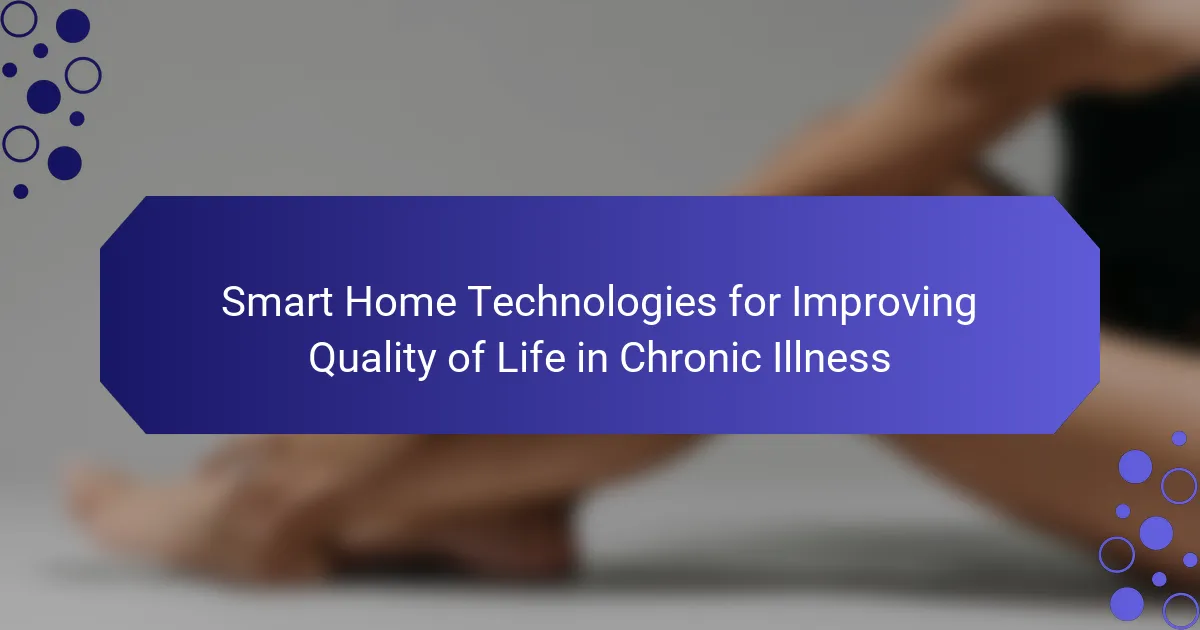Smart home technologies significantly improve the quality of life for individuals with chronic illnesses by enhancing convenience and safety. These innovations automate daily tasks, facilitate health monitoring, and promote independence through voice-activated systems. Real-time data collection aids in personalised care, while automated reminders support treatment adherence. Despite challenges like costs and setup complexity, advancements in this field promise greater support for managing health at home.
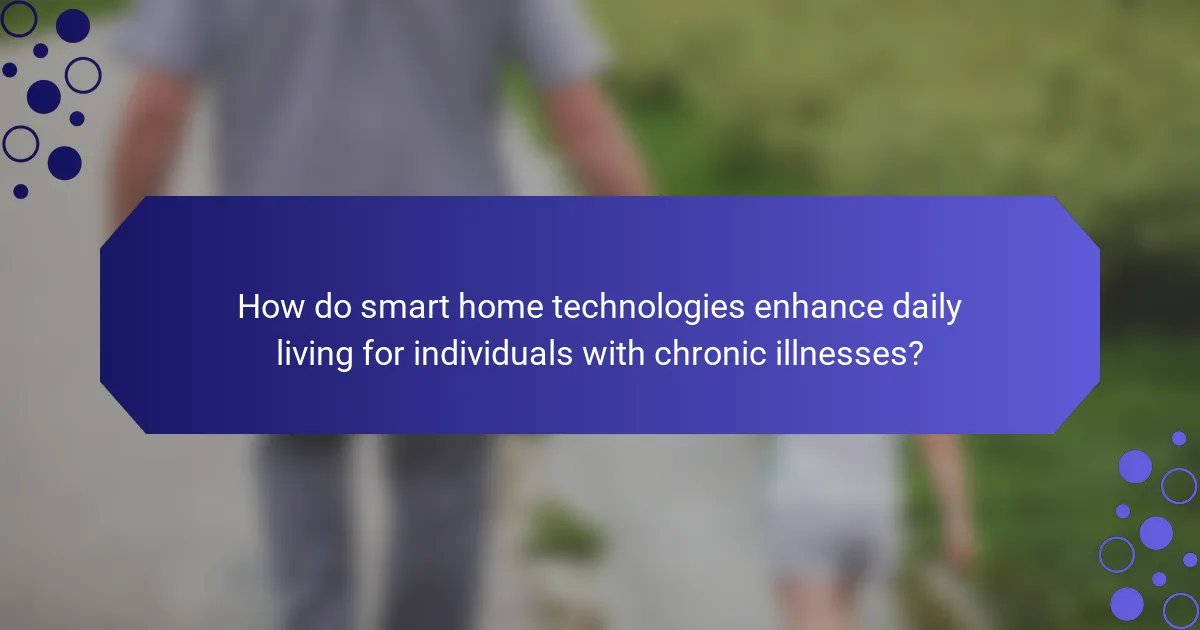
How do smart home technologies enhance daily living for individuals with chronic illnesses?
Smart home technologies significantly enhance daily living for individuals with chronic illnesses by offering convenience, safety, and improved health management. These technologies automate tasks, allowing users to control their environment easily. For instance, smart lighting can adjust based on the time of day, reducing strain on vision.
Health monitoring devices, such as smartwatches, track vital signs continuously, providing real-time data to both users and healthcare providers. This proactive approach enables timely interventions and personalised care plans.
Voice-activated assistants simplify communication and control over home systems, reducing physical strain. Users can manage appliances or request information without needing to move around, which is crucial for those with mobility challenges.
Overall, smart home technologies promote independence and enhance the quality of life, making daily routines more manageable for individuals coping with chronic conditions.
What are the key features of smart home systems that benefit chronic illness management?
Smart home systems enhance chronic illness management through automation, monitoring, and personalised assistance. Key features include remote health monitoring, which tracks vital signs and medication adherence, improving patient outcomes. Integration with wearable devices provides real-time health data, allowing for timely interventions. Voice-activated controls simplify daily tasks, promoting independence. Smart alerts notify caregivers about critical changes, ensuring prompt support. Energy-efficient appliances reduce costs, contributing to overall well-being.
How do smart home devices improve medication adherence and reminders?
Smart home devices enhance medication adherence by providing timely reminders and automating tasks. These technologies utilise alerts, voice assistants, and smart pill dispensers to ensure patients take their medications as prescribed. For instance, smart pill dispensers can track doses and send notifications to caregivers if a dose is missed.
Additionally, integration with health apps allows users to monitor their medication schedules in real-time. This connectivity fosters better communication between patients and healthcare providers, improving overall health outcomes. The unique attribute of these devices lies in their ability to personalise reminders based on user preferences, making adherence more manageable.

What role does automation play in managing chronic health conditions?
Automation significantly enhances the management of chronic health conditions by providing real-time monitoring and personalised care. Smart home technologies, such as automated medication dispensers and health tracking devices, enable patients to adhere to treatment plans effectively. These tools can alert caregivers and healthcare providers about critical health changes, ensuring timely interventions. Additionally, automation reduces the burden of routine tasks, allowing patients to focus on their well-being. Recent studies indicate that patients using smart home technologies report improved quality of life and greater independence in managing their conditions.
Which tasks can be automated to reduce daily stress for individuals with chronic illnesses?
Smart home technologies can automate various tasks to alleviate daily stress for individuals with chronic illnesses. These technologies enhance convenience and promote independence, allowing users to manage their environments effectively.
1. Smart lighting systems can adjust automatically based on the time of day, reducing the need to navigate in low light.
2. Voice-activated assistants can control devices, set reminders for medication, and manage schedules, minimising cognitive load.
3. Smart thermostats can maintain optimal temperatures without manual adjustments, ensuring comfort and reducing fatigue.
4. Automated home security systems can provide peace of mind by monitoring for intrusions, allowing users to focus on health management.
5. Smart appliances can automate cooking and cleaning tasks, saving energy and effort for individuals with limited mobility.
These automated solutions significantly improve quality of life by addressing specific challenges faced by individuals with chronic illnesses.
How can smart home technologies assist with mobility and accessibility challenges?
Smart home technologies enhance mobility and accessibility for individuals with chronic illnesses through automation and remote control. These systems include voice-activated devices, smart lighting, and automated door locks that facilitate easier navigation and daily tasks. For example, smart speakers allow users to control their environment without physical effort. Additionally, smart home technologies can be integrated with health monitoring devices, providing real-time data to caregivers, which improves overall safety and responsiveness. These innovations significantly improve the quality of life by fostering independence and reducing reliance on others for assistance.

How do smart home technologies promote health monitoring and data collection?
Smart home technologies enhance health monitoring and data collection by integrating various devices that track vital signs and daily activities. These technologies include smart wearables, connected medical devices, and home automation systems that collect real-time data.
For instance, smart wearables can monitor heart rate and sleep patterns, providing valuable insights for chronic illness management. Connected devices, such as blood pressure monitors, automatically send data to healthcare providers, facilitating timely interventions. Home automation systems can remind users to take medications and encourage physical activity, promoting overall well-being.
The ability to analyse aggregated data enables personalised health recommendations, improving patient outcomes. Additionally, these technologies foster greater independence for individuals with chronic illnesses, allowing them to manage their health proactively.
What types of health data can be collected through smart home devices?
Smart home devices can collect various health data, enhancing care for chronic illness. Common types include heart rate, blood pressure, sleep patterns, physical activity levels, medication adherence, and glucose levels. These metrics help monitor health status and inform treatment adjustments.
How is the data used to improve care and support for chronic illness patients?
Data from smart home technologies enhances care and support for chronic illness patients by enabling real-time monitoring and personalised interventions. These technologies collect health metrics, such as heart rate and medication adherence, providing caregivers with actionable insights. For instance, automated alerts can notify healthcare providers of significant changes in a patient’s condition. Additionally, smart home systems can facilitate medication management through reminders and tracking, reducing the risk of missed doses. Overall, integrating data analytics in smart home solutions improves patient outcomes and fosters proactive healthcare management.
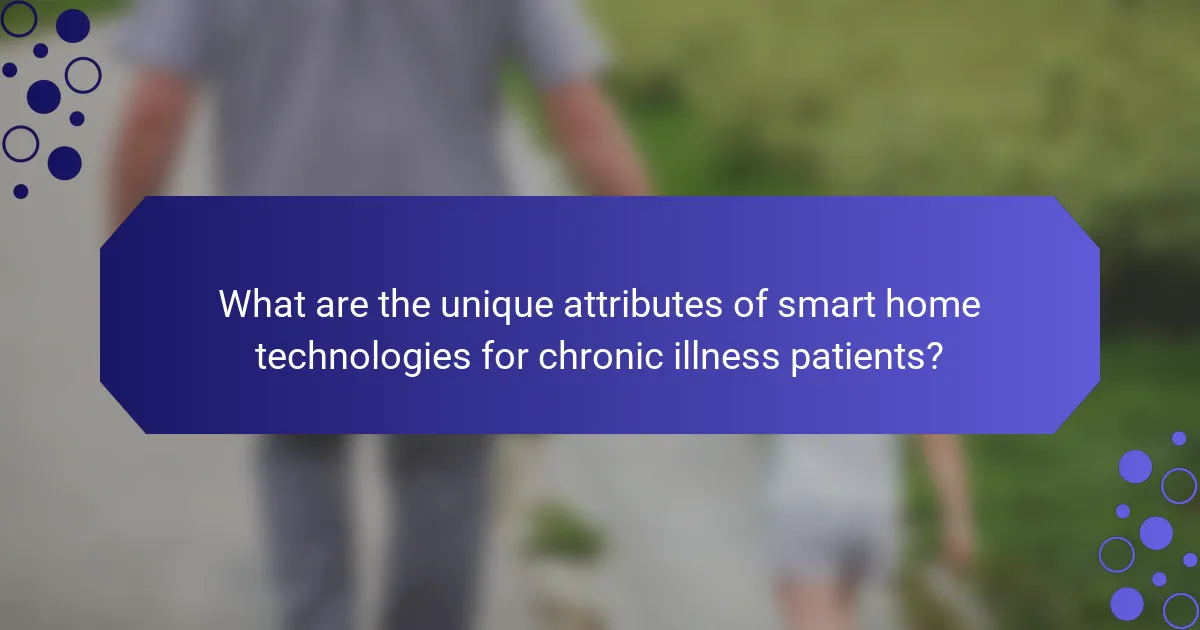
What are the unique attributes of smart home technologies for chronic illness patients?
Smart home technologies offer unique attributes that enhance the quality of life for chronic illness patients. These technologies include remote monitoring capabilities, which allow healthcare providers to track patient health metrics in real-time. Voice-activated systems enable hands-free control of home environments, promoting independence. Customisable alerts remind patients to take medications or attend appointments, ensuring adherence to treatment plans. Integration with wearable devices provides seamless data sharing, enhancing personalised care. Lastly, energy-efficient appliances reduce stress related to household management, contributing to overall well-being.
Which specific smart devices are designed exclusively for chronic illness management?
Smart devices designed exclusively for chronic illness management include medication dispensers, health monitoring systems, and smart home assistants. These technologies enhance daily living by providing reminders, tracking health metrics, and facilitating communication with healthcare providers.
1. Medication Dispensers | Automate medication schedules | Ensure adherence and reduce errors.
2. Health Monitoring Systems | Track vital signs | Provide real-time data to patients and doctors.
3. Smart Home Assistants | Offer voice-activated reminders | Help manage daily tasks and schedules.
4. Wearable Devices | Monitor activity and health metrics | Encourage physical activity and health awareness.
5. Smart Thermostats | Adjust home temperature based on health needs | Improve comfort for chronic conditions.
6. Air Quality Monitors | Track indoor air quality | Help manage respiratory conditions.
How do user experiences differ among various smart home technologies?
User experiences vary significantly among smart home technologies based on their functionality and integration. Devices like smart thermostats enhance comfort by adjusting temperatures automatically, while smart lighting systems improve mood and energy efficiency. Voice-activated assistants provide seamless control over multiple devices, offering convenience and accessibility, particularly for those with chronic illnesses. Security systems, including smart cameras and alarms, enhance safety, providing peace of mind. Each technology addresses unique needs, ultimately contributing to a better quality of life for users managing chronic conditions.
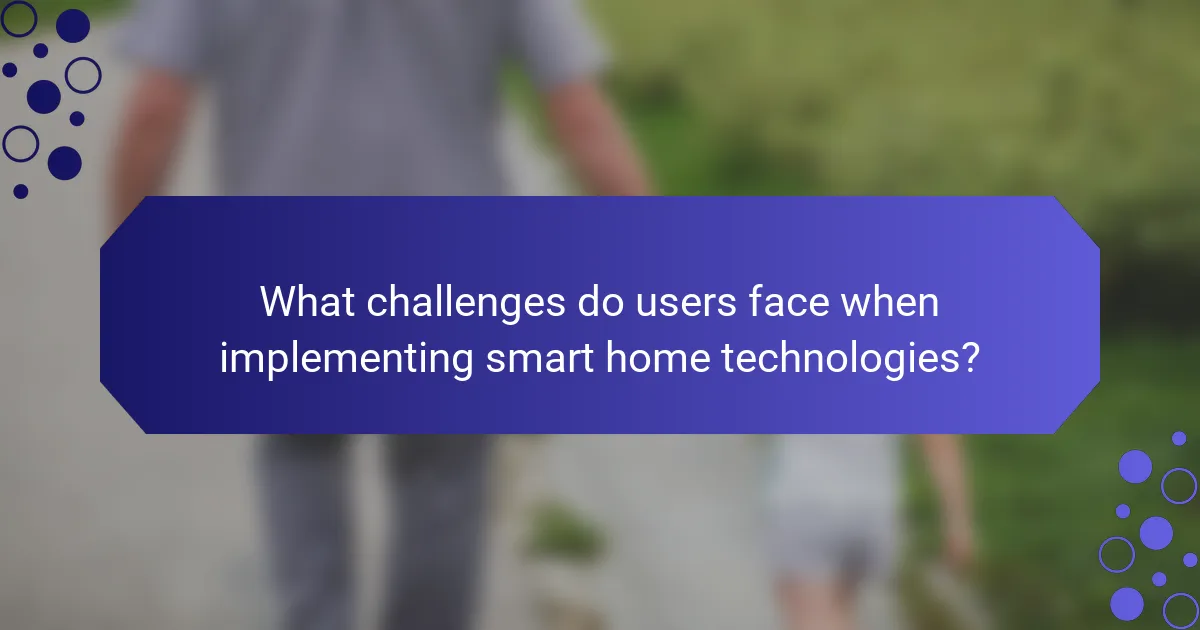
What challenges do users face when implementing smart home technologies?
Users face challenges like high costs, complexity of setup, and compatibility issues when implementing smart home technologies. These factors can hinder the effectiveness of such systems in improving quality of life for individuals with chronic illnesses. Additionally, users may struggle with the learning curve associated with new technologies, leading to frustration and reduced adoption rates. Security concerns regarding data privacy also pose significant barriers, as users may hesitate to integrate devices that require personal information.
What are common technical issues encountered by chronic illness patients?
Chronic illness patients often face technical issues with smart home technologies, including connectivity problems, compatibility issues, user interface challenges, and device malfunctions. These obstacles can hinder the effectiveness of these technologies in improving quality of life.
Connectivity problems arise when devices fail to connect to Wi-Fi or other networks, impacting their functionality. Compatibility issues occur when devices from different manufacturers do not work together seamlessly. User interface challenges can make it difficult for patients to operate devices, especially if they have cognitive impairments. Device malfunctions can lead to unexpected failures, reducing reliability and trust in the technology.
Overall, addressing these common technical issues is essential for maximising the benefits of smart home technologies for chronic illness patients.
How do privacy concerns affect the adoption of smart home technologies?
Privacy concerns significantly hinder the adoption of smart home technologies. Users fear data breaches and unauthorised access to personal information. These technologies often require constant internet connectivity, increasing vulnerability to cyber threats. As a result, potential users may hesitate to integrate smart devices, impacting their ability to manage chronic illnesses effectively. Addressing privacy through robust security measures could enhance trust and encourage broader acceptance of these beneficial technologies.
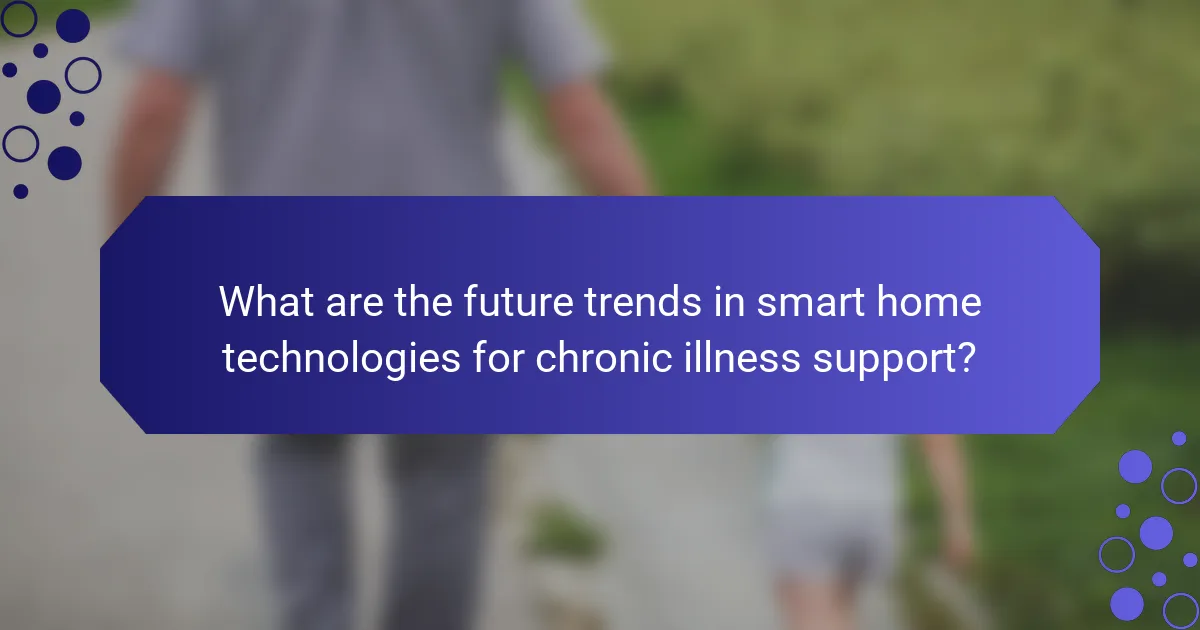
What are the future trends in smart home technologies for chronic illness support?
Future trends in smart home technologies for chronic illness support include advanced monitoring systems, AI-driven health insights, and increased automation. These innovations enhance patient independence and provide real-time data to caregivers. For example, wearables will integrate seamlessly with home systems to track vital signs and medication adherence. Additionally, voice-activated devices will simplify daily tasks, reducing the burden on individuals with chronic conditions. Enhanced interoperability among devices will create a cohesive ecosystem, ensuring comprehensive support for managing health at home.
How is artificial intelligence shaping the next generation of smart home devices?
Artificial intelligence is revolutionising smart home devices by enhancing their ability to assist individuals with chronic illnesses. These technologies offer personalised health monitoring, automated medication reminders, and environmental adjustments tailored to user needs. For instance, AI-driven systems can learn user patterns and optimise settings for comfort and safety, improving overall quality of life. Additionally, smart home devices can integrate with telehealth services, facilitating remote medical consultations and tracking health metrics effectively.
What advancements are being made in interoperability among smart home systems?
Advancements in interoperability among smart home systems focus on seamless communication between devices. These developments enhance user experience and improve health monitoring for chronic illness management. For instance, new protocols like Matter enable devices from different manufacturers to work together efficiently. This integration supports better data sharing and automation, allowing for tailored health solutions. As a result, users can benefit from a more cohesive smart home environment that promotes well-being and simplifies daily tasks.
What best practices should users consider when integrating smart home technologies into their lives?
Users should prioritise compatibility, security, and user-friendliness when integrating smart home technologies. Start by ensuring devices work seamlessly together and can be controlled via a single app or platform. Prioritise devices with strong security features to protect personal data. Choose user-friendly interfaces that simplify operation, especially for those with chronic illnesses. Consider voice-activated systems for hands-free control, enhancing accessibility. Regularly update software to maintain security and functionality. Finally, evaluate energy efficiency to reduce costs and environmental impact.
